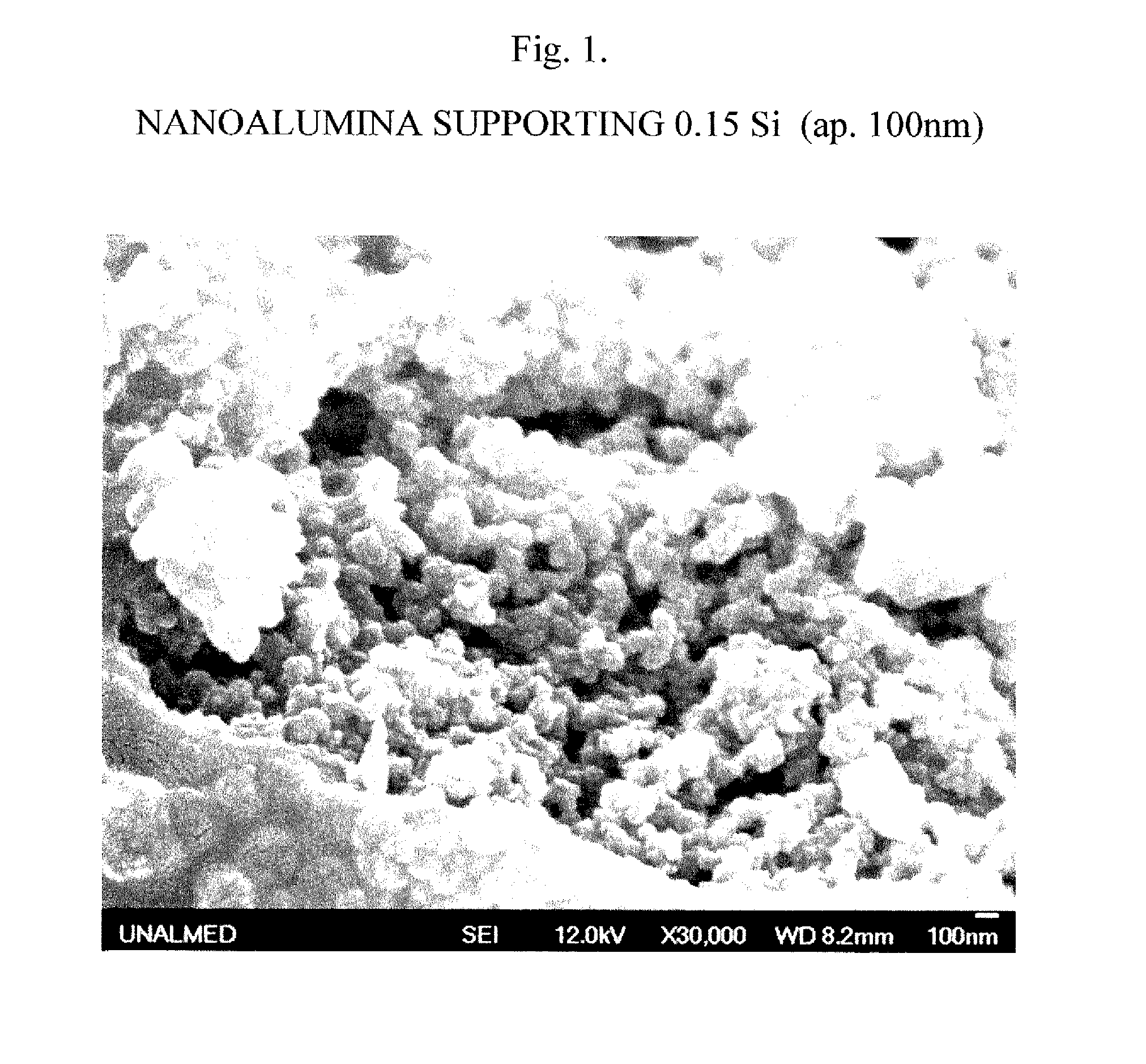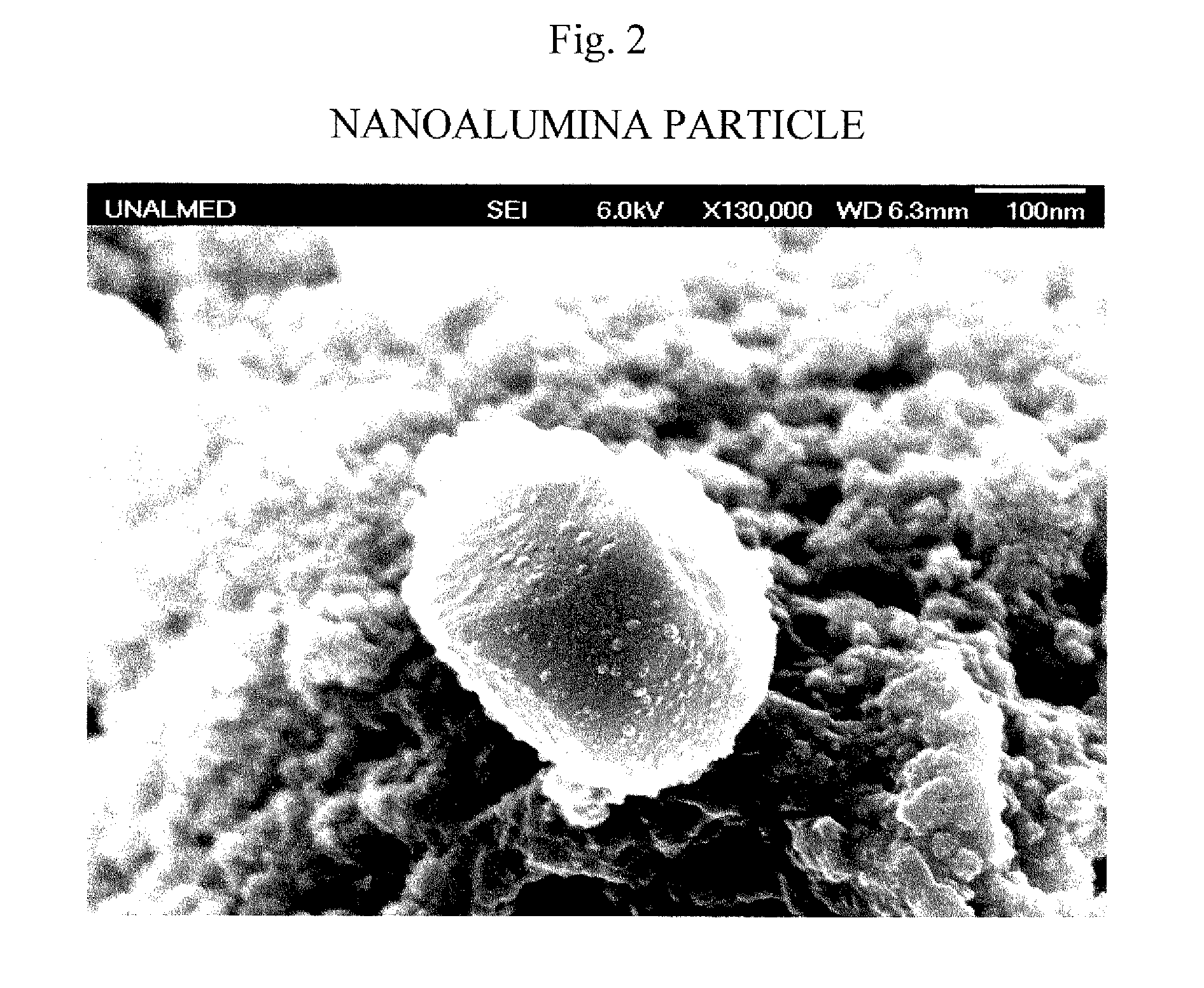Nanofluids for oil recovery from tight light oil reservoirs and methods of their use
a technology of tight light oil reservoirs and nanoparticles, which is applied in the field of nanoparticle compositions, fluids, fluid removal, etc., can solve the problems of high closure stress, large non-extractable oil reserves in these formations, and large fragmentation and disintegration of proppant particles under high closure stress
- Summary
- Abstract
- Description
- Claims
- Application Information
AI Technical Summary
Benefits of technology
Problems solved by technology
Method used
Image
Examples
example 1
Preparation of Calcinated Alumina Nanoparticles
[0141]Aluminum hydroxide (120 kg) is poured in a 2000 liter stainless steel settling tank containing 2% w / w sodium hydroxide solution (1000 kg) with gently agitation (60 RPM) for 1 hour to completely dissolve the aluminum hydroxide. 10% w / w sulfuric acid solution is slowly added to the basic aluminum hydroxide solution. The pH was monitored until the pH of the combined solution was 6.2±0.3. Amorphous aluminate precipitated from the acidified mixture. The mixture was allowed to continue to precipitate and settle for 48 hours; then the excess of liquid was slowly decanted. The precipitate was mixed with deionized water (800 kg) under slow agitation for 1 hour to rinse it and then allowed to settle and precipitate again from the mixture over a week (7 days). The excess liquid was slowly decanted, and the rinsing, decanting, settling process was repeated. The precipitated aluminate was collected and dried at 200° C. and then calcined for 1 ...
example 2
[0146]Anhydrous sodium silicate (0.15 grams) was dissolved in 50% sodium hydroxide (5 g) at 37° C. and gently stirred per 1 hour. Then, glycerin (0.15 grams, isolated from Jatropha oil (obtained from Petroraza (Colombia)) and deionized water (95 grams) were added to the solution and the temperature was increased to 75° C. in a water bath equipped with a sonicator. The silicate / glycerin solution was sonicated for 6 hours at 75° C., and subsequently placed in a spray nozzle.
[0147]Amorphous nano-alumina (99.85 grams, Example 1), and having a diameter ranging between 65 and 120 nm as measured by dynamic light scattering (VASCO)) was gently dispersed on a ceramic plate. Using the spray nozzle, the dispersed nano-alumina was wetted with the silicate / glycerin solution employing the incipient wetness method.
The wetted nano-alumina was dried for 2 hours at 287° C. and then calcined for 4 hours at 650° C. The diameter of the calcined nano-alumina particles containing 0.1 grams Si on the surfa...
example 3
[0148]A nanofluid containing silicon supported on alumina was prepared as follows. Ethanol (99.9 grams) was placed into a 200 mL beaker. Alumina nanoparticles (0.1 grams) supporting 0.15% Si (from Example 2) with an average size of 80-120 nm were added to the ethanol. The solution was sonicated for 2 hours at room temperature (about 20° C.).
[0149]To evaluate the effect of the nanofluid on Light oil viscosity, we injected the nanofluid (0.05 grams) as prepared above into a sample of Bakken light oil (8 grams). The light oil was obtained from a tight formation in Bakken, N. Dak. The oil viscosity was measured at 76° F. before and after the application of nanofluid. The initial light oil viscosity at 76° F. was determined to be 0.16 cp, as measured by a BROOKFIELD DV2T VISCOMETER using the spindle SC4-18. The DV2T Viscometer uses the methodology of rotational digital viscometers. The viscosity of the same oil after addition of the nanofluid at 76° F. was determined to be 0.14 cp.
PUM
 Login to View More
Login to View More Abstract
Description
Claims
Application Information
 Login to View More
Login to View More - R&D
- Intellectual Property
- Life Sciences
- Materials
- Tech Scout
- Unparalleled Data Quality
- Higher Quality Content
- 60% Fewer Hallucinations
Browse by: Latest US Patents, China's latest patents, Technical Efficacy Thesaurus, Application Domain, Technology Topic, Popular Technical Reports.
© 2025 PatSnap. All rights reserved.Legal|Privacy policy|Modern Slavery Act Transparency Statement|Sitemap|About US| Contact US: help@patsnap.com



